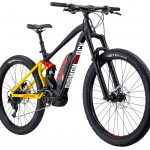D
Deleted member 4366
Guest
If you want to do serious downhill riding, you need your wheels to be as light as possible so that the suspension can work properly. Bicycle suspension springing and damping is designed to handle a wheel with a mass of about 2kg. Doubling the mass of the wheel would compromise it. The result would be a choppy ride and less time that the tyre is in contact with the ground. If you want to do downhill, like in those videos, it wouldn't be sensible to fit a heavy hub-gear system, neither would it be sensible to use a hub-motor. Sure, you could ride down the hill on anything - even a hardtail or an over-weight Kalkhoff, but it's not going to be the same as a bike with a lightweight wheel and proper proper suspension.
You probably know all this, but here's an explanation in relation to cars. The same parameters and relationships apply on a bicycle:
http://www.wheels-inmotion.co.uk/forum/index.php?showtopic=1462
Here's a bike that might represent the epitome of downhill bike design. The rear swinging-arm pivot is on the ideal line to the steering head, the brake torque resisted by the chassis and the gears are in the centre of the bike to reduce the rear unsprung weight. I guess you'll be seeing a lot of MTBs fitted with centre gearboxes in the future. It wouldn't make sense to add a hub-motor, though:
 [/URL]
[/URL]
You probably know all this, but here's an explanation in relation to cars. The same parameters and relationships apply on a bicycle:
http://www.wheels-inmotion.co.uk/forum/index.php?showtopic=1462
Here's a bike that might represent the epitome of downhill bike design. The rear swinging-arm pivot is on the ideal line to the steering head, the brake torque resisted by the chassis and the gears are in the centre of the bike to reduce the rear unsprung weight. I guess you'll be seeing a lot of MTBs fitted with centre gearboxes in the future. It wouldn't make sense to add a hub-motor, though:
 [/URL]
[/URL]
Last edited by a moderator:














